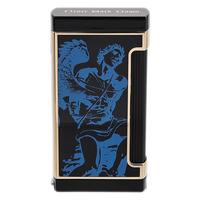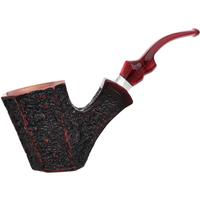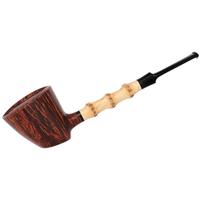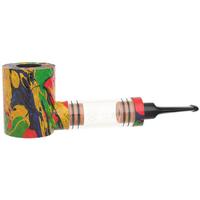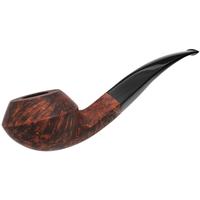The change in coloration makes me wonder about how unfinished (unstained and unwaxed) pipes change color. I think the general notion is that the heat and tars from the tobacco are cooking in a darker color, but this thread would suggest that the wood darkens with time perhaps entirely unrelated to being part of a smoking pipes. My oldest Savinelli pipes bought as unfinished and almost white like new 2X4's have mellowed over 35 or 40 years to a deep resonant walnut color that looks quite deep, maybe not quite a piano finish but deeper than most well stained new pipes.
The Difference in Colour of Aged Briar
- Thread starter kenbarnes
- Start date
You are using an out of date browser. It may not display this or other websites correctly.
You should upgrade or use an alternative browser.
You should upgrade or use an alternative browser.
- Status
- Not open for further replies.
I wonder if the color differences might be partly attributable to other factors beyond age of the block, like the natural variation between briar burls. Within a single block I've seen significantly darker reddish sections amongst the mostly blonde. Other factors could be soil conditions, weather, and maybe even how the briar was processed by the supplier/cutter. Some of these might also affect the hardness, density, and friability of the briar.
Thanks for bringing us along for the ride, Ken. Love how a topic such as this can generate great input and observations. As an earlier member mentioned, this is what the site is meant for, great discussions about pipes.
This is local variation on this stuff, certain mills ship slightly darker product in general, others slightly lighter. Early on, I can recognize a block just by the cut marks and color, honestly. Later... less and less, and it gets to where there are times that unless I've marked on a block where it was from, after 5 or 8 years, I lose track and honestly can't say which mill or which region it's from. Of note, Mimmo buys wood from all over the mediterranean for his mill, his wood is not "local", and yet it all emerges from his process basically the same golden/pink color, very uniform indeed, so obviously the process is more important than the particular block.I wonder if the color differences might be partly attributable to other factors beyond age of the block, like the natural variation between briar burls. Within a single block I've seen significantly darker reddish sections amongst the mostly blonde. Other factors could be soil conditions, weather, and maybe even how the briar was processed by the supplier/cutter. Some of these might also affect the hardness, density, and friability of the briar.
While time does has a part in briar color, I find that the most important factor is the place of origin in terms of soil and briar mill processing.
I can make pretty deep brown briar if I boil it on same pot and water with other 2-3 batches
I can make pretty deep brown briar if I boil it on same pot and water with other 2-3 batches
Nope Todd, but I live in place where briar grows and before I end up buying stuff I went to try harvest my own.
I have even make pipes from unboiled briar and boiled after rough shaping.
I have even make pipes from unboiled briar and boiled after rough shaping.
These two pipes have been sanded and mopped in exactly the same way and are now ready for fitting and finishing. The old dark briar bowl was incredibly hard to sandpaper and heavier than a standard Billiard shape of that size. I notice that the chamber-drill has left burn marks in the tobacco chamber. The lighter one is high-grade plateau from Tuscany which was a joy to sand. I must say that there is a vast difference in the quality of the briar!

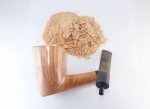
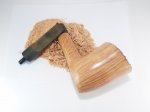




Both lovely, but really digging the dark one.These two pipes have been sanded and mopped in exactly the same way and are now ready for fitting and finishing. The old dark briar bowl was incredibly hard to sandpaper and heavier than a standard Billiard shape of that size. I notice that the chamber-drill has left burn marks in the tobacco chamber. The lighter one is high-grade plateau from Tuscany which was a joy to sand. I must say that there is a vast difference in the quality of the briar!View attachment 26037View attachment 26038View attachment 26039View attachment 26041
An interesting discussion. The question for me is which pipe will smoke better- the briar aged two years "on the shelf" or one with many more years of "shelf age"? Of course there are several other factors to consider which will affect the quality of the smoke. Some we all know are : boiling at the saw mill, chamber drill profile, draft hole placement and the uniformity of air flow from chamber to button. Unfortunately, one can't really hold all of these variables constant to do an accurate experiment so reliance on individual experience is all there is, it seems to me. On the average, wood that I know had a long shelf life , about 5 years to 15 years produced a better smoking pipe than younger wood. The older the better. Castello for example, uses briar that's been 10 years on the shelf ( allegedly) and many say their pipes are the best tasting"off the rack" pipes you can get today. That despite the clearly evident fact that many of their pipes are not very well constructed. Older wood making up for other sins?
I have about 4 pipes by Johs and they seem notably lightweight for their size, which to me is good, easy on the teeth and jaw. Does this suggest younger briar, or lighter color under the rustication? They are Group 4's that weigh out like Group 3's.
Tom- I believe that weight is less a function of age, but of the particular briar. Some are less dense than others, regardless of age. Dryness will help, but after a certain point, you can't get briar drier without drastic results. (such as over-kilning- may lead to cracking and splitting.)
Hopefully, some pipe makers with direct experience can weigh in.
jpm, my Johs have certainly been road tested. Most are over ten years old, I believe. Mogen Johansen makes a lot of pipes and sells them at moderate prices to say the least. I've always been intrigued that his pipes seem significantly lighter than pipes by others at similar sizes. But he has been involved in pipe making for a long time, so I think he has cultivated briar sources that provide this feature.
- Status
- Not open for further replies.



